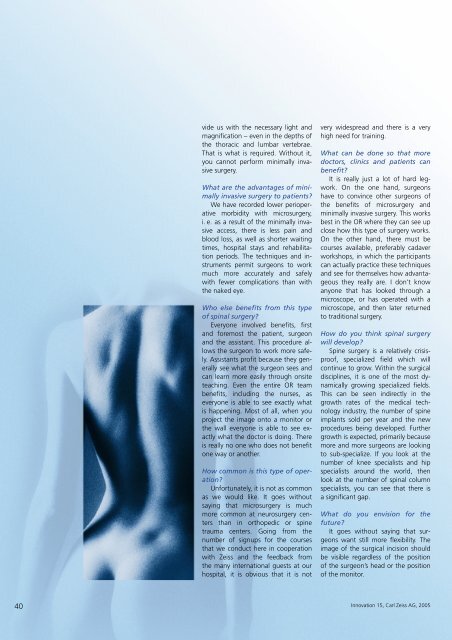Download PDF - Carl Zeiss
Download PDF - Carl Zeiss
Download PDF - Carl Zeiss
You also want an ePaper? Increase the reach of your titles
YUMPU automatically turns print PDFs into web optimized ePapers that Google loves.
40<br />
vide us with the necessary light and<br />
magnification – even in the depths of<br />
the thoracic and lumbar vertebrae.<br />
That is what is required. Without it,<br />
you cannot perform minimally invasive<br />
surgery.<br />
What are the advantages of minimally<br />
invasive surgery to patients?<br />
We have recorded lower perioperative<br />
morbidity with microsurgery,<br />
i. e. as a result of the minimally invasive<br />
access, there is less pain and<br />
blood loss, as well as shorter waiting<br />
times, hospital stays and rehabilitation<br />
periods. The techniques and instruments<br />
permit surgeons to work<br />
much more accurately and safely<br />
with fewer complications than with<br />
the naked eye.<br />
Who else benefits from this type<br />
of spinal surgery?<br />
Everyone involved benefits, first<br />
and foremost the patient, surgeon<br />
and the assistant. This procedure allows<br />
the surgeon to work more safely.<br />
Assistants profit because they generally<br />
see what the surgeon sees and<br />
can learn more easily through onsite<br />
teaching. Even the entire OR team<br />
benefits, including the nurses, as<br />
everyone is able to see exactly what<br />
is happening. Most of all, when you<br />
project the image onto a monitor or<br />
the wall everyone is able to see exactly<br />
what the doctor is doing. There<br />
is really no one who does not benefit<br />
one way or another.<br />
How common is this type of operation?<br />
Unfortunately, it is not as common<br />
as we would like. It goes without<br />
saying that microsurgery is much<br />
more common at neurosurgery centers<br />
than in orthopedic or spine<br />
trauma centers. Going from the<br />
number of signups for the courses<br />
that we conduct here in cooperation<br />
with <strong>Zeiss</strong> and the feedback from<br />
the many international guests at our<br />
hospital, it is obvious that it is not<br />
very widespread and there is a very<br />
high need for training.<br />
What can be done so that more<br />
doctors, clinics and patients can<br />
benefit?<br />
It is really just a lot of hard legwork.<br />
On the one hand, surgeons<br />
have to convince other surgeons of<br />
the benefits of microsurgery and<br />
minimally invasive surgery. This works<br />
best in the OR where they can see up<br />
close how this type of surgery works.<br />
On the other hand, there must be<br />
courses available, preferably cadaver<br />
workshops, in which the participants<br />
can actually practice these techniques<br />
and see for themselves how advantageous<br />
they really are. I don’t know<br />
anyone that has looked through a<br />
microscope, or has operated with a<br />
microscope, and then later returned<br />
to traditional surgery.<br />
How do you think spinal surgery<br />
will develop?<br />
Spine surgery is a relatively crisisproof,<br />
specialized field which will<br />
continue to grow. Within the surgical<br />
disciplines, it is one of the most dynamically<br />
growing specialized fields.<br />
This can be seen indirectly in the<br />
growth rates of the medical technology<br />
industry, the number of spine<br />
implants sold per year and the new<br />
procedures being developed. Further<br />
growth is expected, primarily because<br />
more and more surgeons are looking<br />
to sub-specialize. If you look at the<br />
number of knee specialists and hip<br />
specialists around the world, then<br />
look at the number of spinal column<br />
specialists, you can see that there is<br />
a significant gap.<br />
What do you envision for the<br />
future?<br />
It goes without saying that surgeons<br />
want still more flexibility. The<br />
image of the surgical incision should<br />
be visible regardless of the position<br />
of the surgeon’s head or the position<br />
of the monitor.<br />
Innovation 15, <strong>Carl</strong> <strong>Zeiss</strong> AG, 2005
















